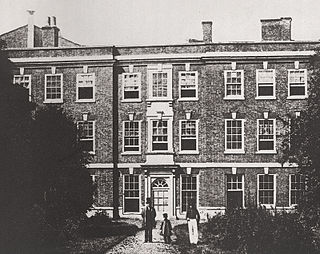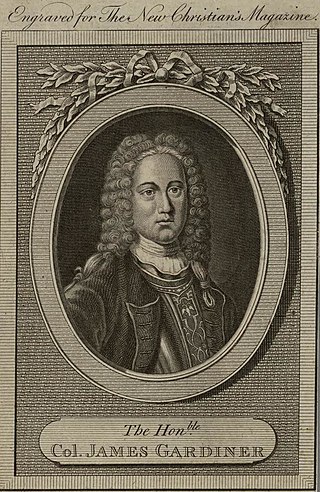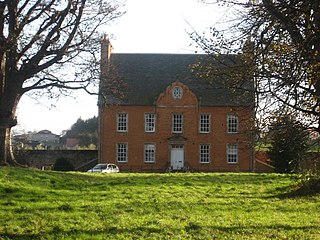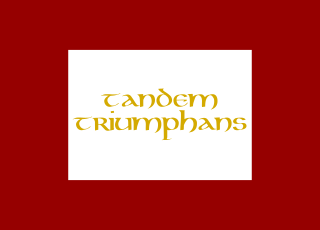
The Bayeux Tapestry is an embroidered cloth nearly 70 metres long and 50 centimetres tall that depicts the events leading up to the Norman Conquest of England in 1066, led by William, Duke of Normandy challenging Harold II, King of England, and culminating in the Battle of Hastings. It is thought to date to the 11th century, within a few years of the battle. Now widely accepted to have been made in England perhaps as a gift for William, it tells the story from the point of view of the conquering Normans and for centuries has been preserved in Normandy.

Charles Edward Louis John Sylvester Maria Casimir Stuart was the elder son of James Francis Edward Stuart, grandson of James VII and II, and the Stuart claimant to the thrones of England, Scotland and Ireland from 1766 as Charles III. During his lifetime, he was also known as "the Young Pretender" and "the Young Chevalier"; in popular memory, he is known as Bonnie Prince Charlie.

Exeter House was an early 17th-century brick-built mansion, which stood in Full Street, Derby until 1854. Named for the Earls of Exeter, whose family owned the property until 1757, the house was notable for the stay of Charles Edward Stuart during the Jacobite rising of 1745. Exeter House was replaced by offices, which in turn were replaced by Charles Herbert Aslin's Magistrates' Courts, built on the site during 1935. The courts were closed at the beginning of 2004, and after a decade vacant the building returned to use as an office development, Riverside Chambers.

The Battle of Prestonpans, also known as the Battle of Gladsmuir, was fought on 21 September 1745, near Prestonpans, in East Lothian, the first significant engagement of the Jacobite rising of 1745.

The Battle of Falkirk Muir, or Battle of Falkirk, took place near Falkirk, Scotland, on 17 January 1746 during the Jacobite rising of 1745. A narrow Jacobite victory, it had little impact on the campaign.

Colonel James Gardiner was a Scottish soldier who fought in the British Army, including during the 1745 Jacobite rising, in which he was killed at the Battle of Prestonpans.

Prestonpans is a small mining town, situated approximately eight miles east of Edinburgh, Scotland, in the council area of East Lothian. The population as of 2020 is 10,460. It is near the site of the 1745 Battle of Prestonpans. Prestonpans is "Scotland's Mural Town", with many murals depicting local history.

Clan Murray is a Highland Scottish clan. The chief of the Clan Murray holds the title of Duke of Atholl. Their ancestors were the Morays of Bothwell who established the family in Scotland in the 12th century. In the 16th century, descendants of the Morays of Bothwell, the Murrays of Tullibardine, secured the chiefship of the clan and were created Earls of Tullibardine in 1606. The first Earl of Tullibardine married the heiress to the Stewart earldom of Atholl and Atholl therefore became a Murray earldom in 1626. The Murray Earl of Atholl was created Marquess of Atholl in 1676 and in 1703 it became a dukedom. The marquess of Tullibardine title has continued as a subsidiary title, being bestowed on elder sons of the chief until they succeed him as Duke of Atholl.

Archibald Cameron of Lochiel was a Scottish physician and prominent leader in the Jacobite rising of 1745. He was the personal physician of Charles Edward Stuart, and younger brother of Donald Cameron of Lochiel, otherwise known as the Gentle Lochiel, who led Clan Cameron during the rising. In 1753 at Tyburn, he was executed for high treason, being the last Jacobite to be executed. In popular memory, he is sometimes referred to as Doctor Archie.
Events from the year 1745 in Great Britain.

The Jacobite rising of 1745, also known as the Forty-five Rebellion or simply the '45, was an attempt by Charles Edward Stuart to regain the British throne for his father, James Francis Edward Stuart. It took place during the War of the Austrian Succession, when the bulk of the British Army was fighting in mainland Europe, and proved to be the last in a series of revolts that began in March 1689, with major outbreaks in 1708, 1715 and 1719.

Bankton House is a late 17th-century house situated south of Prestonpans in East Lothian, Scotland. The house is located between the A1 road and the East Coast Main Line railway at grid reference NT394736.
Alistair Murray Moffat is a Scottish writer and journalist, former director of the Edinburgh Festival Fringe, and former Rector of the University of St Andrews.

The Great Tapestry of Scotland is one of the world's largest community arts projects, hand stitched by 1,000 people from across Scotland. It is made up of 160 linen panels and 300 miles of wool – enough to stretch the entire length of Scotland. It is now on permanent display in its own purpose-built gallery and visitor centre in the town of Galashiels in the heartland of the Scottish Borders.

The Scottish Diaspora Tapestry is a large embroidery, 153 metres (502 ft) in length, crafted from 305 panels that were embroidered in 34 countries. It was the second major tapestry project to have originated from the Prestoungrange Arts Festival in Prestonpans, East Lothian, Scotland. Work on the panels began in 2012. A version of the tapestry was exhibited across Scotland in 2014 for the Homecoming. The tapestry was displayed in locations around Western Europe the following year. November 2015 was the first time that all 305 panels were shown together. In 2016 and 2017 the tapestry toured across Australia and Canada and returned to Edinburgh to go on display in May 2017.

Andrew Thomas Crummy is a Scottish artist, who has designed several major works such as the Great Tapestry of Scotland (2013).

The Jacobite Army, sometimes referred to as the Highland Army, was the military force assembled by Charles Edward Stuart and his Jacobite supporters during the 1745 Rising that attempted to restore the House of Stuart to the British throne.
Archibald Stewart of Mitcham MP (1697–1780) was an 18th-century Scottish merchant and politician who served as Lord Provost of Edinburgh during the critical Jacobite Rebellion of 1745. He was imprisoned in the Tower of London for over a year owing to his alleged negligence.

HMS Fox was a 20-gun sixth-rate frigate of the Royal Navy. She was constructed at Rotherhithe by John Buxton senior, and launched in 1740. Fox was part of the 1733 Establishment built in response to the upcoming War of the Austrian Succession and spent the majority of her career patrolling for privateers and smaller hostile craft, and protecting convoys. She was active during the Jacobite rising of 1745, contributing troops at the Battle of Prestonpans and protecting the advancing army and supplies of John Cope, before succumbing to a storm off Dunbar on 14 November 1745.

Prestonpans Town Hall is a municipal building on the High Street of Prestonpans, East Lothian, Scotland. The building, which is largely used as a community events venue, is a Category C listed building.






















